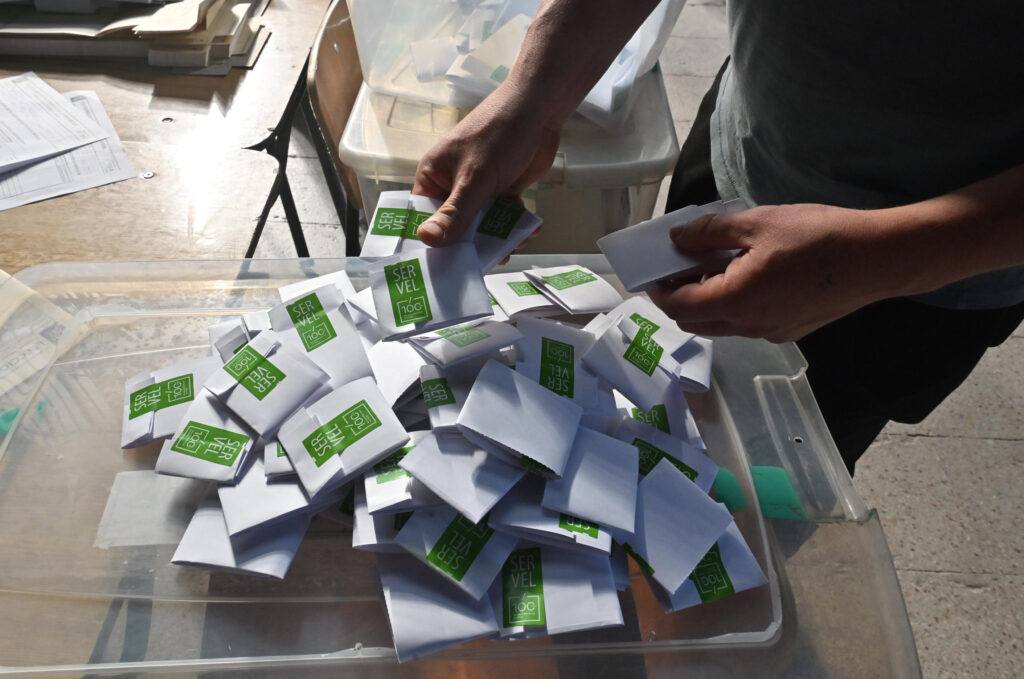Décès de Xavier Emmanuelli, le médecin des exclus, de MSF au Samu social
Médecin des exclus et pionnier de l’action humanitaire, Xavier Emmanuelli, qui a confondé Médecins sans frontières avant d’inventer le Samu social, une ONG d’assistance aux personnes sans-abri, est décédé dimanche à l’âge de 87 ans.”Avec lui disparaît un grand humaniste de notre République”, a salué le président Emmanuel Macron sur le réseau social X.Ce médecin anesthésiste-réanimateur de formation “a dédié sa vie à l’urgence et à l’action humanitaire”, a écrit sa famille dans un communiqué transmis à l’AFP: “Il est mort comme il a vécu, avec des semelles de vent”.Le Samu social international, dont Xavier Emmanuelli était toujours président d’honneur, a rendu hommage “à cette personnalité exceptionnelle pour son engagement sans faille au sein de l’association qu’il a présidée pendant plus de 25 ans et dont il a porté toutes les batailles”. Xavier Emmanuelli “a eu un malaise, probablement cardiaque” et sa vie “s’est arrêtée brutalement”, a précisé à l’AFP le président de l’organisation, Jacques Carles.Il avait fondé en 1993 le Samu social de Paris qui vient, entre autres, en aide aux personnes sans-abri et en grande précarité et les oriente vers un lieu d’hébergement via le numéro d’urgence 115. Avant de créer le Samu social international en 1998.- “Ça me dérange” -“Ça me faisait chier de voir que les gens sont à l’abandon, que ça fait partie du mobilier urbain et que c’est seulement en hiver qu’on s’en rappelle. Ça me dérange. Comme médecin, je suis assez bouleversé”, expliquait-il à propos de la création du Samu social.Pour dénoncer une réduction drastique de financement public, il avait claqué la porte de l’organisation parisienne en 2011, tout en restant au Samu social international.Xavier Emmanuelli a “marqué l’histoire de la solidarité dans le monde”, a souligné l’association, expliquant que “plus d’une quinzaine de Samu sociaux” viennent aujourd’hui en aide aux adultes sans abri, enfants des rues, réfugiés et déplacés à travers le monde.D’origine corse, né à Paris le 23 août 1938, Xavier Emmanuelli était le fils d’un instituteur devenu médecin généraliste et d’une institutrice, tous deux résistants, distingués comme “Justes parmi les nations” après avoir caché des juifs pendant la guerre.Anticolonialiste, dessinateur occasionnel pour le magazine Hara-Kiri, il avait cofondé en 1971 Médecins sans frontières, qui a reçu le prix Nobel de la paix en 1999: “C’est mon histoire d’amour, vraiment”, racontait-il dans un sourire attendri.- “Grand par l’exemple” -C’est lors de consultations dans un centre d’aide aux sans-abris à Nanterre qu’il avait eu l’idée d’appliquer aux problèmes sociaux les méthodes de l’urgence médicale. “J’ai regardé, cliniquement, ce que cela représentait la grande exclusion. Le Samu social vient de là”, avait-il expliqué.Jacques Chirac, alors maire de Paris, l’avait aidé à créer fin 1993 les premières équipes mobiles du Samu social, chargées d'”aller à la rencontre” des sans-abris. Au début de la présidence Chirac, en 1995, il avait été nommé secrétaire d’État à l’Action humanitaire d’urgence (1995-1997).Pour autant, “je n’ai épousé ni les idées de droite ni celles de gauche”, expliquait en 2011 celui qui fut communiste dans sa jeunesse.Membre du conseil de l’Office français de protection des réfugiés et apatrides (Ofpra) et de la commission nationale consultative des droits de l’homme, il avait également présidé le Haut comité au logement des personnes défavorisés de 1997 à 2015, rappelle sa famille.Son décès a déclenché une pluie d’hommages. “Son engagement a marqué notre pays”, a réagi sur X le ministre du Travail et des Solidarités Jean-Pierre Farandou. “Je garde le souvenir d’un homme de fidélité, à la fois exigeant, fraternel, profondément humaniste, toujours tourné vers l’action concrète. Son rôle fut décisif dans la genèse du droit au logement opposable”, a souligné sur le réseau social l’ancien Premier ministre (2005-2007) Dominique de Villepin, saluant “l’une des grandes consciences sociales” de la France. “Visionnaire, médecin voué aux autres, grand par l’exemple”, a salué le leader de LFI Jean-Luc Mélenchon.
Décès de Xavier Emmanuelli, le médecin des exclus, de MSF au Samu social
Médecin des exclus et pionnier de l’action humanitaire, Xavier Emmanuelli, qui a confondé Médecins sans frontières avant d’inventer le Samu social, une ONG d’assistance aux personnes sans-abri, est décédé dimanche à l’âge de 87 ans.”Avec lui disparaît un grand humaniste de notre République”, a salué le président Emmanuel Macron sur le réseau social X.Ce médecin anesthésiste-réanimateur de formation “a dédié sa vie à l’urgence et à l’action humanitaire”, a écrit sa famille dans un communiqué transmis à l’AFP: “Il est mort comme il a vécu, avec des semelles de vent”.Le Samu social international, dont Xavier Emmanuelli était toujours président d’honneur, a rendu hommage “à cette personnalité exceptionnelle pour son engagement sans faille au sein de l’association qu’il a présidée pendant plus de 25 ans et dont il a porté toutes les batailles”. Xavier Emmanuelli “a eu un malaise, probablement cardiaque” et sa vie “s’est arrêtée brutalement”, a précisé à l’AFP le président de l’organisation, Jacques Carles.Il avait fondé en 1993 le Samu social de Paris qui vient, entre autres, en aide aux personnes sans-abri et en grande précarité et les oriente vers un lieu d’hébergement via le numéro d’urgence 115. Avant de créer le Samu social international en 1998.- “Ça me dérange” -“Ça me faisait chier de voir que les gens sont à l’abandon, que ça fait partie du mobilier urbain et que c’est seulement en hiver qu’on s’en rappelle. Ça me dérange. Comme médecin, je suis assez bouleversé”, expliquait-il à propos de la création du Samu social.Pour dénoncer une réduction drastique de financement public, il avait claqué la porte de l’organisation parisienne en 2011, tout en restant au Samu social international.Xavier Emmanuelli a “marqué l’histoire de la solidarité dans le monde”, a souligné l’association, expliquant que “plus d’une quinzaine de Samu sociaux” viennent aujourd’hui en aide aux adultes sans abri, enfants des rues, réfugiés et déplacés à travers le monde.D’origine corse, né à Paris le 23 août 1938, Xavier Emmanuelli était le fils d’un instituteur devenu médecin généraliste et d’une institutrice, tous deux résistants, distingués comme “Justes parmi les nations” après avoir caché des juifs pendant la guerre.Anticolonialiste, dessinateur occasionnel pour le magazine Hara-Kiri, il avait cofondé en 1971 Médecins sans frontières, qui a reçu le prix Nobel de la paix en 1999: “C’est mon histoire d’amour, vraiment”, racontait-il dans un sourire attendri.- “Grand par l’exemple” -C’est lors de consultations dans un centre d’aide aux sans-abris à Nanterre qu’il avait eu l’idée d’appliquer aux problèmes sociaux les méthodes de l’urgence médicale. “J’ai regardé, cliniquement, ce que cela représentait la grande exclusion. Le Samu social vient de là”, avait-il expliqué.Jacques Chirac, alors maire de Paris, l’avait aidé à créer fin 1993 les premières équipes mobiles du Samu social, chargées d'”aller à la rencontre” des sans-abris. Au début de la présidence Chirac, en 1995, il avait été nommé secrétaire d’État à l’Action humanitaire d’urgence (1995-1997).Pour autant, “je n’ai épousé ni les idées de droite ni celles de gauche”, expliquait en 2011 celui qui fut communiste dans sa jeunesse.Membre du conseil de l’Office français de protection des réfugiés et apatrides (Ofpra) et de la commission nationale consultative des droits de l’homme, il avait également présidé le Haut comité au logement des personnes défavorisés de 1997 à 2015, rappelle sa famille.Son décès a déclenché une pluie d’hommages. “Son engagement a marqué notre pays”, a réagi sur X le ministre du Travail et des Solidarités Jean-Pierre Farandou. “Je garde le souvenir d’un homme de fidélité, à la fois exigeant, fraternel, profondément humaniste, toujours tourné vers l’action concrète. Son rôle fut décisif dans la genèse du droit au logement opposable”, a souligné sur le réseau social l’ancien Premier ministre (2005-2007) Dominique de Villepin, saluant “l’une des grandes consciences sociales” de la France. “Visionnaire, médecin voué aux autres, grand par l’exemple”, a salué le leader de LFI Jean-Luc Mélenchon.
Décès de Xavier Emmanuelli, le médecin des exclus, de MSF au Samu social
Médecin des exclus et pionnier de l’action humanitaire, Xavier Emmanuelli, qui a confondé Médecins sans frontières avant d’inventer le Samu social, une ONG d’assistance aux personnes sans-abri, est décédé dimanche à l’âge de 87 ans.”Avec lui disparaît un grand humaniste de notre République”, a salué le président Emmanuel Macron sur le réseau social X.Ce médecin anesthésiste-réanimateur de formation “a dédié sa vie à l’urgence et à l’action humanitaire”, a écrit sa famille dans un communiqué transmis à l’AFP: “Il est mort comme il a vécu, avec des semelles de vent”.Le Samu social international, dont Xavier Emmanuelli était toujours président d’honneur, a rendu hommage “à cette personnalité exceptionnelle pour son engagement sans faille au sein de l’association qu’il a présidée pendant plus de 25 ans et dont il a porté toutes les batailles”. Xavier Emmanuelli “a eu un malaise, probablement cardiaque” et sa vie “s’est arrêtée brutalement”, a précisé à l’AFP le président de l’organisation, Jacques Carles.Il avait fondé en 1993 le Samu social de Paris qui vient, entre autres, en aide aux personnes sans-abri et en grande précarité et les oriente vers un lieu d’hébergement via le numéro d’urgence 115. Avant de créer le Samu social international en 1998.- “Ça me dérange” -“Ça me faisait chier de voir que les gens sont à l’abandon, que ça fait partie du mobilier urbain et que c’est seulement en hiver qu’on s’en rappelle. Ça me dérange. Comme médecin, je suis assez bouleversé”, expliquait-il à propos de la création du Samu social.Pour dénoncer une réduction drastique de financement public, il avait claqué la porte de l’organisation parisienne en 2011, tout en restant au Samu social international.Xavier Emmanuelli a “marqué l’histoire de la solidarité dans le monde”, a souligné l’association, expliquant que “plus d’une quinzaine de Samu sociaux” viennent aujourd’hui en aide aux adultes sans abri, enfants des rues, réfugiés et déplacés à travers le monde.D’origine corse, né à Paris le 23 août 1938, Xavier Emmanuelli était le fils d’un instituteur devenu médecin généraliste et d’une institutrice, tous deux résistants, distingués comme “Justes parmi les nations” après avoir caché des juifs pendant la guerre.Anticolonialiste, dessinateur occasionnel pour le magazine Hara-Kiri, il avait cofondé en 1971 Médecins sans frontières, qui a reçu le prix Nobel de la paix en 1999: “C’est mon histoire d’amour, vraiment”, racontait-il dans un sourire attendri.- “Grand par l’exemple” -C’est lors de consultations dans un centre d’aide aux sans-abris à Nanterre qu’il avait eu l’idée d’appliquer aux problèmes sociaux les méthodes de l’urgence médicale. “J’ai regardé, cliniquement, ce que cela représentait la grande exclusion. Le Samu social vient de là”, avait-il expliqué.Jacques Chirac, alors maire de Paris, l’avait aidé à créer fin 1993 les premières équipes mobiles du Samu social, chargées d'”aller à la rencontre” des sans-abris. Au début de la présidence Chirac, en 1995, il avait été nommé secrétaire d’État à l’Action humanitaire d’urgence (1995-1997).Pour autant, “je n’ai épousé ni les idées de droite ni celles de gauche”, expliquait en 2011 celui qui fut communiste dans sa jeunesse.Membre du conseil de l’Office français de protection des réfugiés et apatrides (Ofpra) et de la commission nationale consultative des droits de l’homme, il avait également présidé le Haut comité au logement des personnes défavorisés de 1997 à 2015, rappelle sa famille.Son décès a déclenché une pluie d’hommages. “Son engagement a marqué notre pays”, a réagi sur X le ministre du Travail et des Solidarités Jean-Pierre Farandou. “Je garde le souvenir d’un homme de fidélité, à la fois exigeant, fraternel, profondément humaniste, toujours tourné vers l’action concrète. Son rôle fut décisif dans la genèse du droit au logement opposable”, a souligné sur le réseau social l’ancien Premier ministre (2005-2007) Dominique de Villepin, saluant “l’une des grandes consciences sociales” de la France. “Visionnaire, médecin voué aux autres, grand par l’exemple”, a salué le leader de LFI Jean-Luc Mélenchon.
Masters ATP: Sinner étourdit Alcaraz et reste le maître à domicile
Pour la deuxième année consécutive, Jannik Sinner a remporté le Masters ATP en battant dimanche à Turin son grand rival Carlos Alcaraz, étourdissant épilogue d’une saison où il a connu bien des hauts et quelques bas.Devant le public survolté de l’Inalpi Arena, Sinner a fini par faire craquer Alcaraz, sans doute diminué par une gêne à la cuisse droite, en deux sets 7-6 (7/4), 7-5 après deux heures et 15 minutes de jeu.L’Italien est définitivement sans rival sur dur indoor et dans les Finales ATP qui opposent les huit meilleurs joueurs de l’année.Il a enchaîné une 31e victoire de suite sur sa surface de prédilection et un dixième succès consécutif dans le “tournoi des maîtres” depuis sa défaite en finale de l’édition 2023 contre Novak Djokovic, sans perdre un seul set !Dans cette finale opposant pour la première fois depuis 2016 les deux meilleurs joueurs de l’année, il a fallu attendre le onzième jeu pour que l’un des finalistes, jusque là souverains sur leur mise en jeu, se retrouve en danger.A 6-5, mis en difficulté par l’agressivité d’Alcaraz et ses amorties, Sinner a dû repousser une premier balle de break mais s’est sorti d’affaires avec son service.- Sixième titre en 2025 -Dans le jeu décisif, Alcaraz s’est retrouvé à son tour dos au mur quand Sinner a vite pris le large grâce notamment à deux lobs gagnants.Le tenant du titre a débuté le deuxième set de la pire des façons et cédé sa mise en jeu avec notamment deux double fautes.Mené 3-1, il a fini par rétablir la situation avec un peu de réussite après une volée de revers complétement raté d’Alcaraz et un retour boisé pour égaliser à 3-3.C’est finalement sur le service d’Alcaraz, de plus en plus fébrile et frustré, que Sinner a fait la différence et concrétisé sa première balle de match, avant de fêter son titre, une fois n’est pas coutume, de façon démonstrative.”Ca a été une semaine superbe qui s’est finie par une finale disputée dans une ambiance de stade de football”, a souligné l’Italien qui a disputé les finales des cinq tournois les plus importants de l’année.Sinner, 23 ans, finit l’année comme il l’avait débuté, à Melbourne, avec une victoire en finale pour porter son palmarès à 24 titres depuis ses débuts, dont six cette année.S’il a remporté deux titres du Grand Chelem (Open d’Australie et Wimbledon), ainsi que le Masters ATP, l’Italien va terminer l’année à la deuxième place mondiale.- “Je serai prêt” -La faute à Alcaraz qui a remporté les deux autres titres majeurs (Roland-Garros et US Open) pour un total de huit titres. La faute surtout à sa suspension de trois mois en début d’année pour des contrôles positifs à un anabolisant.Il y a dans le tennis actuel Alcaraz et Sinner, et loin derrière tous les autres: ils ont remporté à eux deux les huit derniers titres du Grand Chelem.”Carlitos” mène certes largement au bilan de leurs confrontations, dix victoires à six, dont quatre à deux en 2025, mais l’Espagnol n’est pas encore de taille à rivaliser avec l’Italien sur dur et sous un toît.En vacances dès dimanche soir, au contraire d’Alcaraz qui dispute à partir de mardi à Bologne la Coupe Davis, Sinner entend vite se projeter sur la préparation de 2026, pour une saison où sans pause forcée il veut reprendre l’ascendant sur son grand rival.”J’espère que tu vas être prêt pour la saison prochaine, car moi je serai prêt”, l’a prévenu Alcaraz.
Mondial-2026: la Norvège empoche son billet, l’Italie encore en barrages
Il n’y a pas eu d’incroyable retournement de situation à Milan dimanche: comme attendu, la Norvège s’est qualifiée pour le Mondial-2026 après sa victoire (4-1) contre l’Italie qui, absente des deux dernières Coupes du monde, devra elle à nouveau passer par les barrages.La Norvège qui participera pour la première fois depuis 1998 à une Coupe du monde, a terminé, grâce à un nouveau doublé de sa star Erling Haaland, à la première place du groupe I avec un carton plein de 24 points, soit six de plus que l’Italie.La Nazionale a dominé la première période devant les 69.000 spectateurs de San Siro et a ouvert la marque grâce à son grand espoir Francesco Pio Esposito, son troisième but en cinq sélections à 20 ans, sur un tir en pivot (11e).Changement radical de scénario après la pause: la Norvège, timorée jusque-là, a surclassé l’Italie.Elle a égalisé sur un raid tout en puissance d’Antonio Nusa (63e), puis Haaland a donné l’avantage à son équipe d’une superbe reprise de volée (78e), avant de mettre KO la Nazionale une minute plus tard en profitant d’une mauvaise relance (79e).Jorgen Strand Larsen a ajouté un quatrième but dans le temps additionnel (90e+3).Les “Lions” disputeront seulement leur quatrième phase finale de Coupe du monde, après 1938, 1994 et 1998. Ils affichent pour meilleur résultat un 8e de finale lors de leur dernière participation en France, où ils s’étaient inclinés contre l’Italie (1-0).Haaland et ses coéquipiers ont fini leurs éliminatoires avec un impressionnant bilan de huit victoires en autant de matches, grâce notamment aux 16 buts de l’attaquant de Manchester City qui participera l’été prochain aux Etats-Unis, au Canada et au Mexique à son premier tournoi majeur.- Barrages fatals en 2018 et 2022 -Ils ont fait la différence dans leur duel pour la qualification directe avec l’Italie dès juin avec une démonstration (3-0) sous le pluie d’Oslo (3-0), dont les Azzurri ne se sont jamais remis.Ce camouflet a coûté son poste à Luciano Spalletti, moins de deux ans après sa nomination. Son successeur Gennaro Gattuso a relancé l’équipe avec cinq victoires consécutives, avant cette cinglante défaite.”On doit présenter nos excuses à nos supporters, finir ces qualifications sur une défaite aussi lourde est inacceptable”, a réagi le sélectionneur italien.”Mais il faut retenir ce qu’on a fait contre une très bonne équipe norvégienne en première période”, a insisté le champion du monde 2006.L’Italie conservait une chance de se qualifier directement pour la prochaine Coupe du monde, mais elle devait battre la Norvège par neuf buts d’écart. Mais même Gattuso n’y croyait pas et avait présenté samedi ce scénario comme “impensable”.Les quadruples champions du monde vont devoir passer fin mars par les barrages qui rappellent forcément des mauvais souvenirs au foot italien et aux tifosi.C’est en barrages que la Nazionale a chuté, contre la Suède pour la Coupe du monde 2018 (défaite 1-0, nul 0-0), et contre la Macédoine du nord (défaite 1-0), pour le Mondial-2022.L’Italie connaitra son parcours vers l’Amérique jeudi après un tirage au sort qui pourrait mettre sur sa route la Suède ou l’Ecosse.
Mondial-2026: la Norvège empoche son billet, l’Italie encore en barrages
Il n’y a pas eu d’incroyable retournement de situation à Milan dimanche: comme attendu, la Norvège s’est qualifiée pour le Mondial-2026 après sa victoire (4-1) contre l’Italie qui, absente des deux dernières Coupes du monde, devra elle à nouveau passer par les barrages.La Norvège qui participera pour la première fois depuis 1998 à une Coupe du monde, a terminé, grâce à un nouveau doublé de sa star Erling Haaland, à la première place du groupe I avec un carton plein de 24 points, soit six de plus que l’Italie.La Nazionale a dominé la première période devant les 69.000 spectateurs de San Siro et a ouvert la marque grâce à son grand espoir Francesco Pio Esposito, son troisième but en cinq sélections à 20 ans, sur un tir en pivot (11e).Changement radical de scénario après la pause: la Norvège, timorée jusque-là, a surclassé l’Italie.Elle a égalisé sur un raid tout en puissance d’Antonio Nusa (63e), puis Haaland a donné l’avantage à son équipe d’une superbe reprise de volée (78e), avant de mettre KO la Nazionale une minute plus tard en profitant d’une mauvaise relance (79e).Jorgen Strand Larsen a ajouté un quatrième but dans le temps additionnel (90e+3).Les “Lions” disputeront seulement leur quatrième phase finale de Coupe du monde, après 1938, 1994 et 1998. Ils affichent pour meilleur résultat un 8e de finale lors de leur dernière participation en France, où ils s’étaient inclinés contre l’Italie (1-0).Haaland et ses coéquipiers ont fini leurs éliminatoires avec un impressionnant bilan de huit victoires en autant de matches, grâce notamment aux 16 buts de l’attaquant de Manchester City qui participera l’été prochain aux Etats-Unis, au Canada et au Mexique à son premier tournoi majeur.- Barrages fatals en 2018 et 2022 -Ils ont fait la différence dans leur duel pour la qualification directe avec l’Italie dès juin avec une démonstration (3-0) sous le pluie d’Oslo (3-0), dont les Azzurri ne se sont jamais remis.Ce camouflet a coûté son poste à Luciano Spalletti, moins de deux ans après sa nomination. Son successeur Gennaro Gattuso a relancé l’équipe avec cinq victoires consécutives, avant cette cinglante défaite.”On doit présenter nos excuses à nos supporters, finir ces qualifications sur une défaite aussi lourde est inacceptable”, a réagi le sélectionneur italien.”Mais il faut retenir ce qu’on a fait contre une très bonne équipe norvégienne en première période”, a insisté le champion du monde 2006.L’Italie conservait une chance de se qualifier directement pour la prochaine Coupe du monde, mais elle devait battre la Norvège par neuf buts d’écart. Mais même Gattuso n’y croyait pas et avait présenté samedi ce scénario comme “impensable”.Les quadruples champions du monde vont devoir passer fin mars par les barrages qui rappellent forcément des mauvais souvenirs au foot italien et aux tifosi.C’est en barrages que la Nazionale a chuté, contre la Suède pour la Coupe du monde 2018 (défaite 1-0, nul 0-0), et contre la Macédoine du nord (défaite 1-0), pour le Mondial-2022.L’Italie connaitra son parcours vers l’Amérique jeudi après un tirage au sort qui pourrait mettre sur sa route la Suède ou l’Ecosse.
Présidentielle au Chili : insécurité et migrants sans papiers au coeur du scrutin
Les Chiliens ont voté dimanche pour élire leur président entre deux favoris, la communiste modérée Jeannette Jara et l’ultraconservateur José Antonio Kast, lors d’un scrutin dominé par les inquiétudes liées à la criminalité et à la migration irrégulière. Pour la première fois depuis la fin de la dictature d’Augusto Pinochet en 1990, la droite radicale pourrait revenir au pouvoir.Les bureaux de vote ont commencé à fermer à 18H00 locales (21H00 GMT), ouvrant la voie au dépouillement, au terme d’une journée marquée par de longues files d’attente pour ce scrutin obligatoire. Plus de 15,6 millions d’électeurs étaient appelés à départager huit candidats.”Il faut améliorer la question de la délinquance. Tout est horrible (…) Un changement est nécessaire”, a déclaré à l’AFP Joaquin Castillo, un étudiant de 23 ans en votant à Santiago.Jeannette Jara, candidate de la coalition de centre gauche au pouvoir, arrive en tête des sondages, devant son rival d’extrême droite José Antonio Kast. Mais lors d’un probable second tour, elle serait battue par un candidat de droite ou d’extrême droite, du fait du report des voix.L’extrême droite est aussi portée par Johannes Kaiser, député libertarien en forte progression dans les sondages, souvent présenté comme la version chilienne du président argentin Javier Milei.Bien que le Chili reste l’un des pays les plus sûrs du continent, la criminalité y a sensiblement augmenté. Le taux d’homicides a augmenté de 2,5 à 6 pour 100.000 habitants en une décennie et 868 enlèvements ont été recensés l’an dernier, en hausse de 76% par rapport à 2021, selon les autorités.- “reculer sur tant d’avancées ” -Cette violence inédite a éclipsé les aspirations de changement qui avaient porté au pouvoir en 2022 le président de gauche Gabriel Boric et sa promesse, finalement avortée, d’une nouvelle Constitution pour remplacer celle héritée de Pinochet.”Il manque de la poigne au Chili, on est trop laxistes (…) Il faut fermer la frontière et renvoyer tous les sans-papiers”, a déclaré à l’AFP Raul Lueiza, un ouvrier du bâtiment de 64 ans, après avoir voté dans un quartier populaire de Santiago.”Si l’extrême droite gagne, nous allons reculer sur tant d’avancées obtenues pour les femmes”, estime pour sa part Patricia Orellana, une vendeuse de 56 ans, disant avoir voté pour Mme Jara.La campagne a été dominée par les discours sécuritaires, auxquels Jeannette Jara elle-même s’est ralliée. Membre du Parti communiste depuis l’adolescence, l’ancienne ministre du Travail de 51 ans assure n’avoir “aucun complexe en matière de sécurité”, défendant notamment un contrôle migratoire renforcé. “Exacerber la peur ne suffit pas pour gouverner un pays”, a-t-elle cependant déclaré après avoir déposé son bulletin dans l’urne à Santiago.José Antonio Kast, 59 ans, fils d’un ancien soldat allemand qui a servi pendant la Seconde Guerre mondiale puis a émigré au Chili, brigue la présidence pour la troisième fois. Son discours cible les 337.000 étrangers en situation irrégulière, en majorité des Vénézuéliens, dans un contexte d’inquiétude face à l’arrivée de groupes criminels étrangers. Une majorité de Chiliens associe la montée de la criminalité à l’immigration irrégulière.”Nous avons besoin d’unité pour affronter les problèmes (…) liés à la sécurité”, a déclaré le dirigeant du Parti républicain, père de neuf enfants, en votant dans la capitale. Il promet des expulsions massives, la construction d’un mur à la frontière, le renforcement de l’armement de la police et le déploiement de l’armée dans les zones critiques.Johannes Kaiser, lui, porte des propositions encore plus radicales. Le député libertarien de 49 ans promet lui aussi des expulsions massives, mais veut en outre envoyer les migrants ayant un casier judiciaire dans la mégaprison construite par le président Nayib Bukele au Salvador.”Ce qui se joue ici, c’est de savoir si la déconnexion de l’Amérique latine avec les États-Unis et le monde libre va continuer de s’accentuer”, a-t-il déclaré en réponse à une question de l’AFP après avoir voté à Santiago. Le scrutin fait figure de test pour la gauche sud-américaine, battue récemment en Argentine et en Bolivie, et confrontée à des élections décisives en Colombie et au Brésil en 2026.Les Chiliens renouvellent également la Chambre des députés et la moitié du Sénat.






